Analysis of EIA Drawbacks and Water Recycling Strategies in Australia
VerifiedAdded on 2022/11/22
|8
|1552
|483
Report
AI Summary
This report addresses the main drawbacks of Environmental Impact Assessments (EIA) in New South Wales (NSW), Australia, and contrasts them with practices in South Australia, emphasizing legal and procedural details. It identifies inconsistencies, lack of community engagement, and project uncertainties as key issues in NSW's EIA process. The report then designs a strategy to promote the use of recycled water for drinking, incorporating regulatory tools (like WHO guidelines), economic tools (cost-benefit analysis), and social tools (awareness campaigns and educational programs) to influence public behavior. The strategy includes modifications and examples from Australia and other countries with similar socioeconomic statuses, such as the Sydney Olympic Games' focus on water conservation, to encourage the adoption of sustainable water management practices. The report utilizes a Harvard referencing style and provides a comprehensive analysis of the topic.
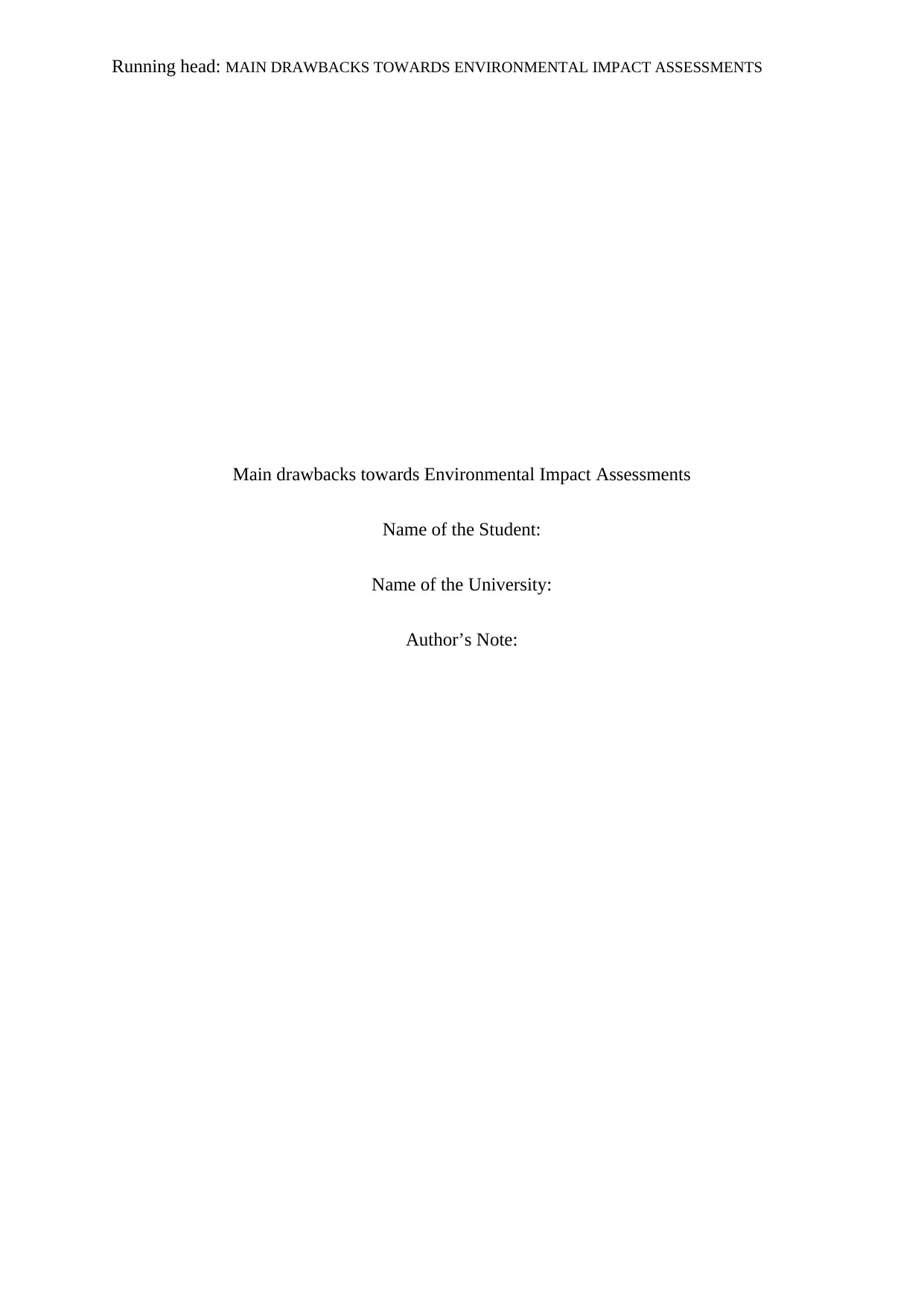
Running head: MAIN DRAWBACKS TOWARDS ENVIRONMENTAL IMPACT ASSESSMENTS
Main drawbacks towards Environmental Impact Assessments
Name of the Student:
Name of the University:
Author’s Note:
Main drawbacks towards Environmental Impact Assessments
Name of the Student:
Name of the University:
Author’s Note:
Paraphrase This Document
Need a fresh take? Get an instant paraphrase of this document with our AI Paraphraser

1MAIN DRAWBACKS TOWARDS ENVIRONMENTAL IMPACT ASSESSMENTS
Question 1:
Main drawbacks behind ways in which Environmental Impact Assessment is conducted
in NSW in the country of Australia:
Definition of Environmental Impact Assessment and reasons behind conduction
Environmental Impact Assessment (EIA), a protocol that helps in assessing various
consequences that may be positive or negative that may have an impact on various policies,
plans or programs before forming decisions in order to undertake various proposed actions. It
is basically utilized and its basic principles can be applied towards development of project
activities by various companies that would undertake assessment due to environmental
strategies (SEA) in regards to various policies or programmes that are proposed in various
states. Assessments at environmental standards are usually governed under the regulations of
administration in association with participation in public levels as well as documentation
processes in formulating decisions.
In the state of New South Wales situated in Australia through establishment of two different
pathways for implementation of EIA protocol under the Environment Planning as well as
Assessment Act in the year 1979. Through initiation of Division 5.2 by the help of EP&A
laws, it helps to provide projects that would help in development of Significant
Infrastructures. The second part that lies under 4th Part, dealings associated with EP&A laws
assist in development of assessments for growth in State, local or regional levels.
Main drawbacks due to this protocol
In order to reform the principles of EIA protocol, the government at New South Wales have
tried to renew the process for Environmental Impact Assessment so that they can contribute
Question 1:
Main drawbacks behind ways in which Environmental Impact Assessment is conducted
in NSW in the country of Australia:
Definition of Environmental Impact Assessment and reasons behind conduction
Environmental Impact Assessment (EIA), a protocol that helps in assessing various
consequences that may be positive or negative that may have an impact on various policies,
plans or programs before forming decisions in order to undertake various proposed actions. It
is basically utilized and its basic principles can be applied towards development of project
activities by various companies that would undertake assessment due to environmental
strategies (SEA) in regards to various policies or programmes that are proposed in various
states. Assessments at environmental standards are usually governed under the regulations of
administration in association with participation in public levels as well as documentation
processes in formulating decisions.
In the state of New South Wales situated in Australia through establishment of two different
pathways for implementation of EIA protocol under the Environment Planning as well as
Assessment Act in the year 1979. Through initiation of Division 5.2 by the help of EP&A
laws, it helps to provide projects that would help in development of Significant
Infrastructures. The second part that lies under 4th Part, dealings associated with EP&A laws
assist in development of assessments for growth in State, local or regional levels.
Main drawbacks due to this protocol
In order to reform the principles of EIA protocol, the government at New South Wales have
tried to renew the process for Environmental Impact Assessment so that they can contribute

2MAIN DRAWBACKS TOWARDS ENVIRONMENTAL IMPACT ASSESSMENTS
towards significant development as well as progress in infrastructural problems. Certain
drawbacks associated with this protocol in NSW are:
a) Stakeholders have been able to identify various problems with processes of EIA as
these were proved to be quite inconsistent as well as it produced certain documents
that were very difficult to realize.
b) Since there was a deficiency in confidence with respect to assessment of various
projects therefore it lead to failure and it also could not put focus on certain
important results and thus led to negligible consideration of various combined
impacts.
c) Stakeholders also identified that there was an urgent need of engagement of better
means of communities that was not present in EIA processes.
d) EIA protocol proved to be complex in certain cases and this ultimately lead to very
indefinite timeframes.
e) Various uncertainties arose in regards to approved project activities and therefore it
could not abide by all the necessary compliances during the time of construction as
well as operations
f) Certain uncertainties arose due to various modifications in project plans and this led
to problems in approving those projects.
Differences in such happenings taking place in Southern Australia
In the state NSW, fracking is usually permitted under the Act of Petroleum Onshore in the
year 1991. Under various regulations associated with planning, operations associated with
fracking usually receive consent due to development in various circumstances. Developments
associated with CSG are usually prohibited within the exclusion or certain buffer zones that
have an impact on society as well as environment. Explorations with respect to CSG as well
as various development factors undergo through protection license agreements under the Act
towards significant development as well as progress in infrastructural problems. Certain
drawbacks associated with this protocol in NSW are:
a) Stakeholders have been able to identify various problems with processes of EIA as
these were proved to be quite inconsistent as well as it produced certain documents
that were very difficult to realize.
b) Since there was a deficiency in confidence with respect to assessment of various
projects therefore it lead to failure and it also could not put focus on certain
important results and thus led to negligible consideration of various combined
impacts.
c) Stakeholders also identified that there was an urgent need of engagement of better
means of communities that was not present in EIA processes.
d) EIA protocol proved to be complex in certain cases and this ultimately lead to very
indefinite timeframes.
e) Various uncertainties arose in regards to approved project activities and therefore it
could not abide by all the necessary compliances during the time of construction as
well as operations
f) Certain uncertainties arose due to various modifications in project plans and this led
to problems in approving those projects.
Differences in such happenings taking place in Southern Australia
In the state NSW, fracking is usually permitted under the Act of Petroleum Onshore in the
year 1991. Under various regulations associated with planning, operations associated with
fracking usually receive consent due to development in various circumstances. Developments
associated with CSG are usually prohibited within the exclusion or certain buffer zones that
have an impact on society as well as environment. Explorations with respect to CSG as well
as various development factors undergo through protection license agreements under the Act
⊘ This is a preview!⊘
Do you want full access?
Subscribe today to unlock all pages.

Trusted by 1+ million students worldwide
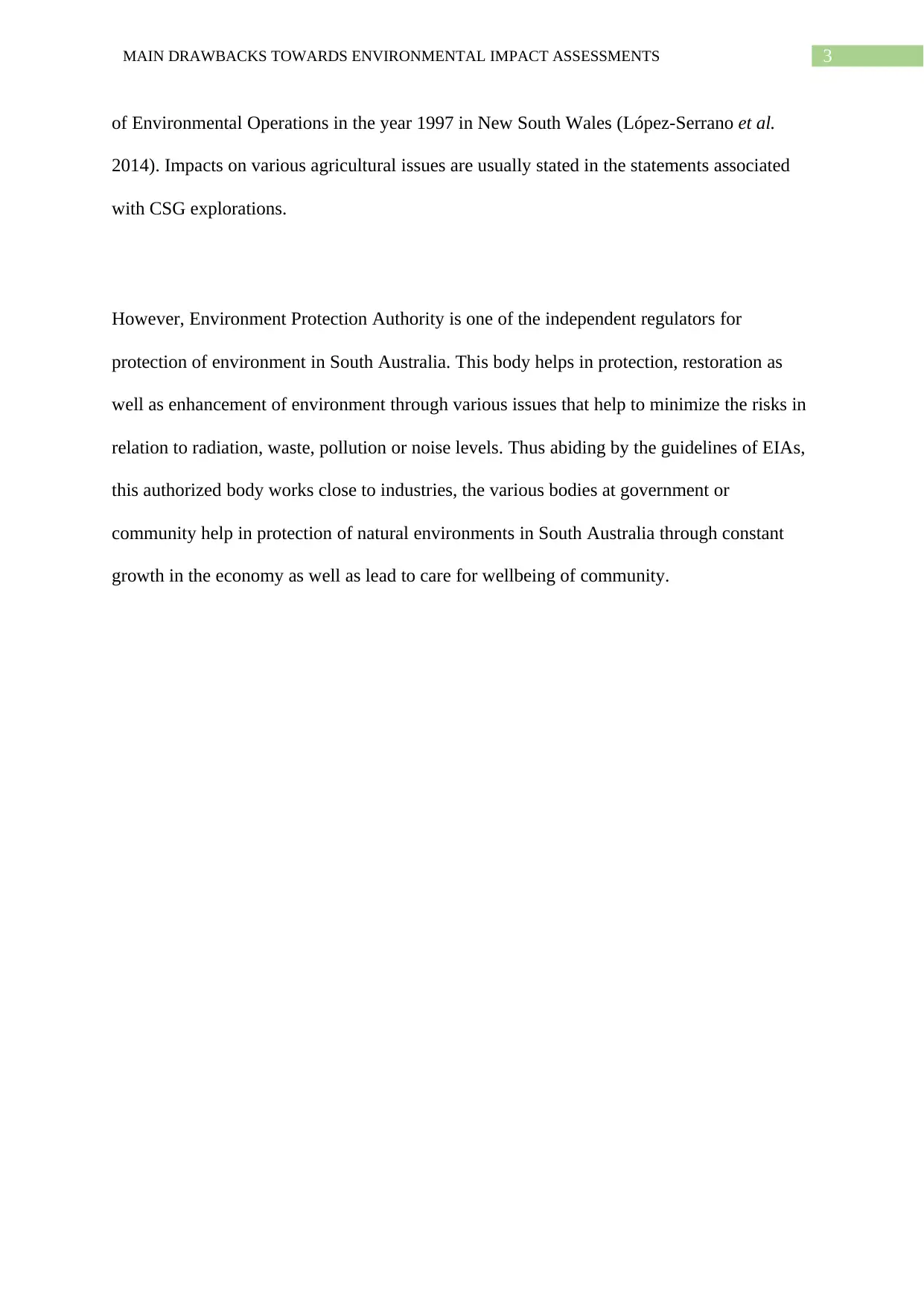
3MAIN DRAWBACKS TOWARDS ENVIRONMENTAL IMPACT ASSESSMENTS
of Environmental Operations in the year 1997 in New South Wales (López-Serrano et al.
2014). Impacts on various agricultural issues are usually stated in the statements associated
with CSG explorations.
However, Environment Protection Authority is one of the independent regulators for
protection of environment in South Australia. This body helps in protection, restoration as
well as enhancement of environment through various issues that help to minimize the risks in
relation to radiation, waste, pollution or noise levels. Thus abiding by the guidelines of EIAs,
this authorized body works close to industries, the various bodies at government or
community help in protection of natural environments in South Australia through constant
growth in the economy as well as lead to care for wellbeing of community.
of Environmental Operations in the year 1997 in New South Wales (López-Serrano et al.
2014). Impacts on various agricultural issues are usually stated in the statements associated
with CSG explorations.
However, Environment Protection Authority is one of the independent regulators for
protection of environment in South Australia. This body helps in protection, restoration as
well as enhancement of environment through various issues that help to minimize the risks in
relation to radiation, waste, pollution or noise levels. Thus abiding by the guidelines of EIAs,
this authorized body works close to industries, the various bodies at government or
community help in protection of natural environments in South Australia through constant
growth in the economy as well as lead to care for wellbeing of community.
Paraphrase This Document
Need a fresh take? Get an instant paraphrase of this document with our AI Paraphraser
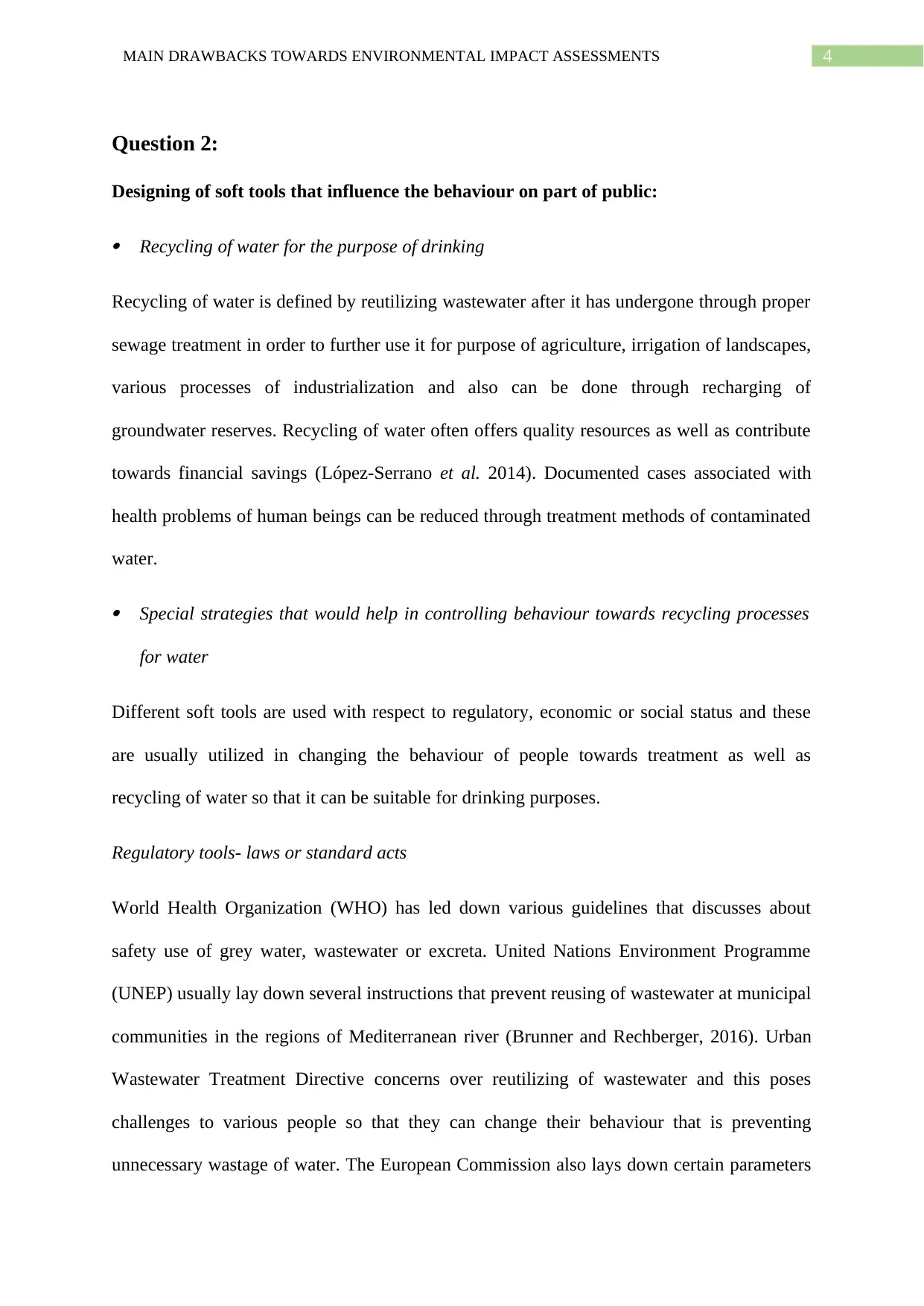
4MAIN DRAWBACKS TOWARDS ENVIRONMENTAL IMPACT ASSESSMENTS
Question 2:
Designing of soft tools that influence the behaviour on part of public:
Recycling of water for the purpose of drinking
Recycling of water is defined by reutilizing wastewater after it has undergone through proper
sewage treatment in order to further use it for purpose of agriculture, irrigation of landscapes,
various processes of industrialization and also can be done through recharging of
groundwater reserves. Recycling of water often offers quality resources as well as contribute
towards financial savings (López-Serrano et al. 2014). Documented cases associated with
health problems of human beings can be reduced through treatment methods of contaminated
water.
Special strategies that would help in controlling behaviour towards recycling processes
for water
Different soft tools are used with respect to regulatory, economic or social status and these
are usually utilized in changing the behaviour of people towards treatment as well as
recycling of water so that it can be suitable for drinking purposes.
Regulatory tools- laws or standard acts
World Health Organization (WHO) has led down various guidelines that discusses about
safety use of grey water, wastewater or excreta. United Nations Environment Programme
(UNEP) usually lay down several instructions that prevent reusing of wastewater at municipal
communities in the regions of Mediterranean river (Brunner and Rechberger, 2016). Urban
Wastewater Treatment Directive concerns over reutilizing of wastewater and this poses
challenges to various people so that they can change their behaviour that is preventing
unnecessary wastage of water. The European Commission also lays down certain parameters
Question 2:
Designing of soft tools that influence the behaviour on part of public:
Recycling of water for the purpose of drinking
Recycling of water is defined by reutilizing wastewater after it has undergone through proper
sewage treatment in order to further use it for purpose of agriculture, irrigation of landscapes,
various processes of industrialization and also can be done through recharging of
groundwater reserves. Recycling of water often offers quality resources as well as contribute
towards financial savings (López-Serrano et al. 2014). Documented cases associated with
health problems of human beings can be reduced through treatment methods of contaminated
water.
Special strategies that would help in controlling behaviour towards recycling processes
for water
Different soft tools are used with respect to regulatory, economic or social status and these
are usually utilized in changing the behaviour of people towards treatment as well as
recycling of water so that it can be suitable for drinking purposes.
Regulatory tools- laws or standard acts
World Health Organization (WHO) has led down various guidelines that discusses about
safety use of grey water, wastewater or excreta. United Nations Environment Programme
(UNEP) usually lay down several instructions that prevent reusing of wastewater at municipal
communities in the regions of Mediterranean river (Brunner and Rechberger, 2016). Urban
Wastewater Treatment Directive concerns over reutilizing of wastewater and this poses
challenges to various people so that they can change their behaviour that is preventing
unnecessary wastage of water. The European Commission also lays down certain parameters
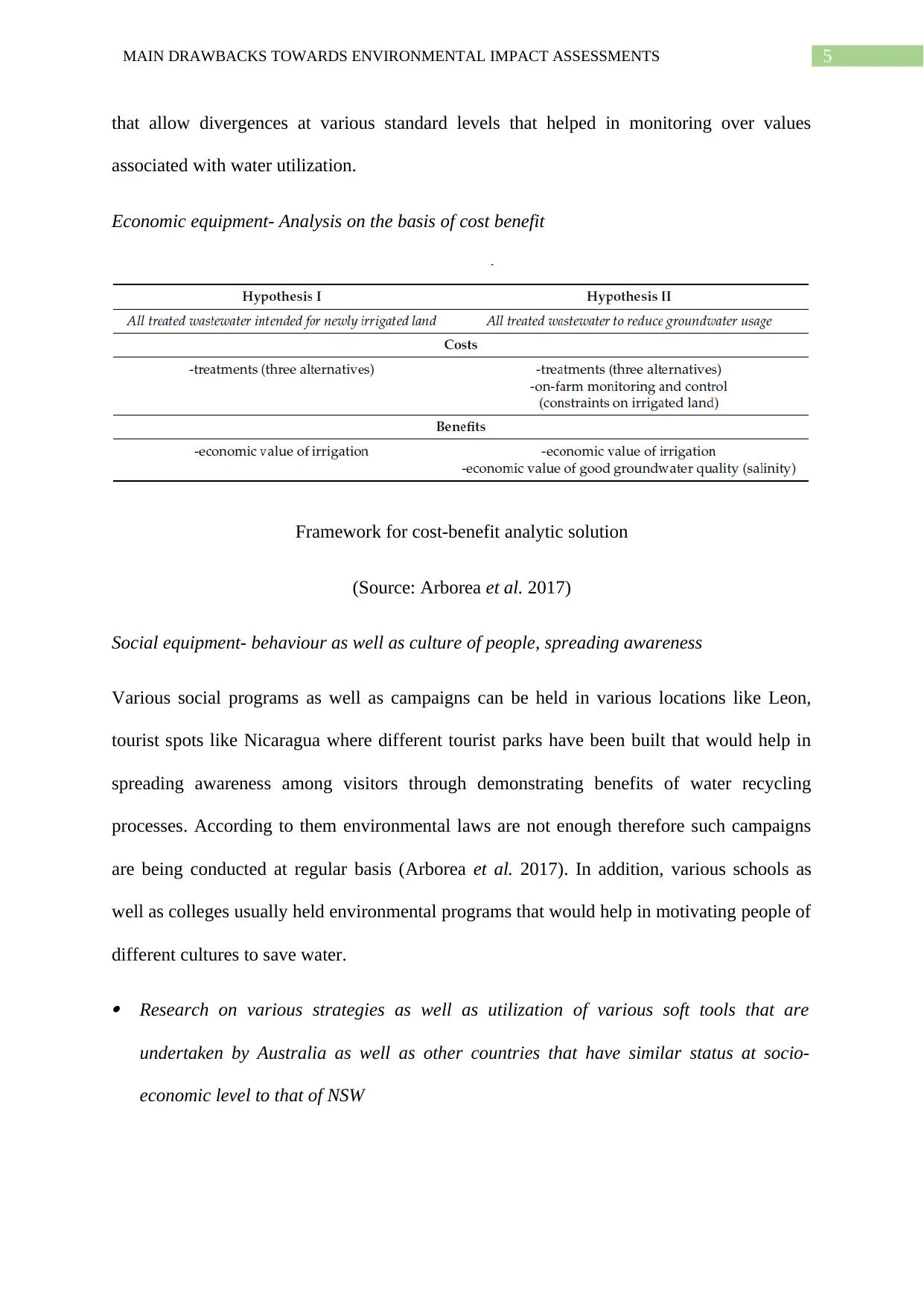
5MAIN DRAWBACKS TOWARDS ENVIRONMENTAL IMPACT ASSESSMENTS
that allow divergences at various standard levels that helped in monitoring over values
associated with water utilization.
Economic equipment- Analysis on the basis of cost benefit
Framework for cost-benefit analytic solution
(Source: Arborea et al. 2017)
Social equipment- behaviour as well as culture of people, spreading awareness
Various social programs as well as campaigns can be held in various locations like Leon,
tourist spots like Nicaragua where different tourist parks have been built that would help in
spreading awareness among visitors through demonstrating benefits of water recycling
processes. According to them environmental laws are not enough therefore such campaigns
are being conducted at regular basis (Arborea et al. 2017). In addition, various schools as
well as colleges usually held environmental programs that would help in motivating people of
different cultures to save water.
Research on various strategies as well as utilization of various soft tools that are
undertaken by Australia as well as other countries that have similar status at socio-
economic level to that of NSW
that allow divergences at various standard levels that helped in monitoring over values
associated with water utilization.
Economic equipment- Analysis on the basis of cost benefit
Framework for cost-benefit analytic solution
(Source: Arborea et al. 2017)
Social equipment- behaviour as well as culture of people, spreading awareness
Various social programs as well as campaigns can be held in various locations like Leon,
tourist spots like Nicaragua where different tourist parks have been built that would help in
spreading awareness among visitors through demonstrating benefits of water recycling
processes. According to them environmental laws are not enough therefore such campaigns
are being conducted at regular basis (Arborea et al. 2017). In addition, various schools as
well as colleges usually held environmental programs that would help in motivating people of
different cultures to save water.
Research on various strategies as well as utilization of various soft tools that are
undertaken by Australia as well as other countries that have similar status at socio-
economic level to that of NSW
⊘ This is a preview!⊘
Do you want full access?
Subscribe today to unlock all pages.

Trusted by 1+ million students worldwide
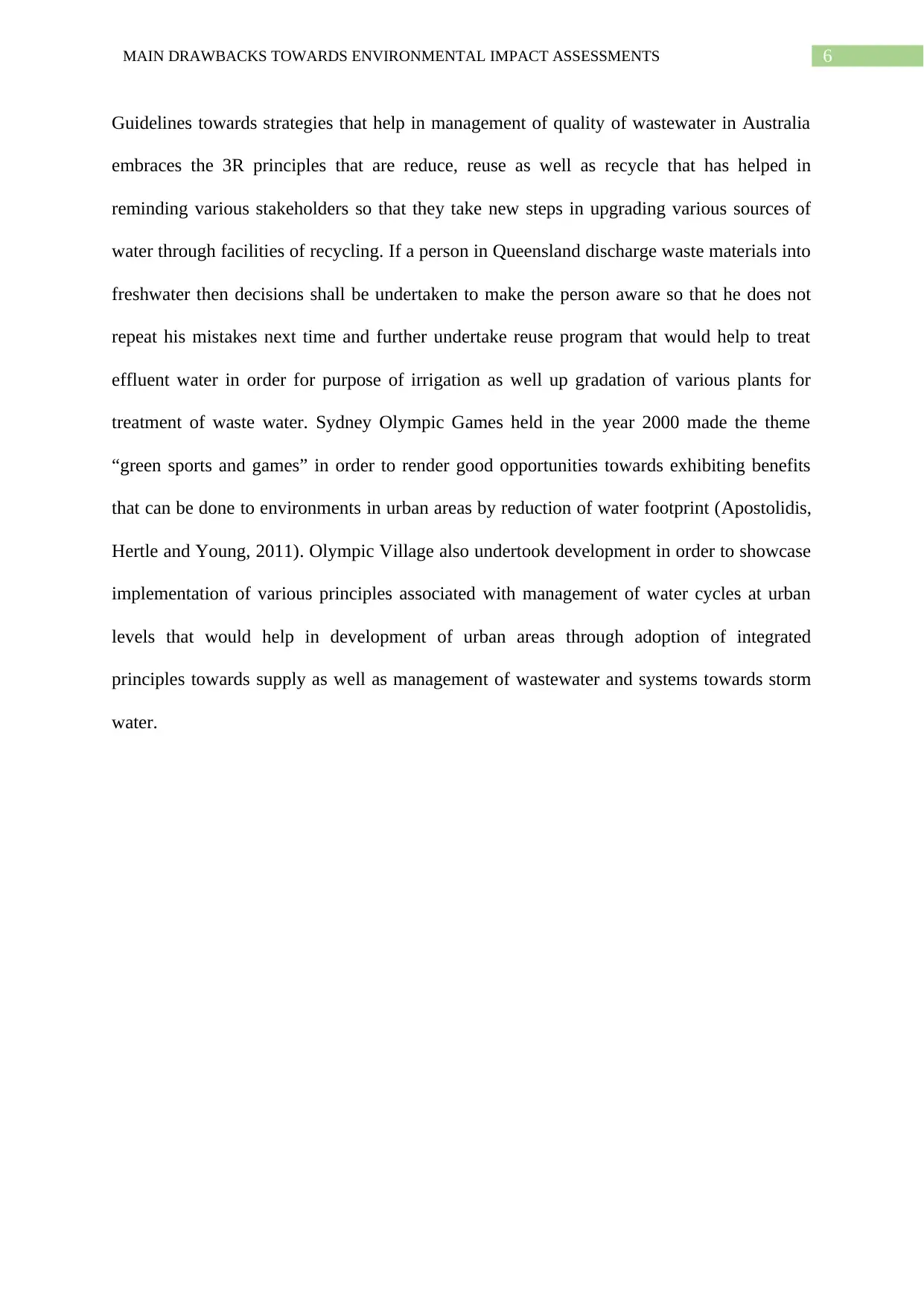
6MAIN DRAWBACKS TOWARDS ENVIRONMENTAL IMPACT ASSESSMENTS
Guidelines towards strategies that help in management of quality of wastewater in Australia
embraces the 3R principles that are reduce, reuse as well as recycle that has helped in
reminding various stakeholders so that they take new steps in upgrading various sources of
water through facilities of recycling. If a person in Queensland discharge waste materials into
freshwater then decisions shall be undertaken to make the person aware so that he does not
repeat his mistakes next time and further undertake reuse program that would help to treat
effluent water in order for purpose of irrigation as well up gradation of various plants for
treatment of waste water. Sydney Olympic Games held in the year 2000 made the theme
“green sports and games” in order to render good opportunities towards exhibiting benefits
that can be done to environments in urban areas by reduction of water footprint (Apostolidis,
Hertle and Young, 2011). Olympic Village also undertook development in order to showcase
implementation of various principles associated with management of water cycles at urban
levels that would help in development of urban areas through adoption of integrated
principles towards supply as well as management of wastewater and systems towards storm
water.
Guidelines towards strategies that help in management of quality of wastewater in Australia
embraces the 3R principles that are reduce, reuse as well as recycle that has helped in
reminding various stakeholders so that they take new steps in upgrading various sources of
water through facilities of recycling. If a person in Queensland discharge waste materials into
freshwater then decisions shall be undertaken to make the person aware so that he does not
repeat his mistakes next time and further undertake reuse program that would help to treat
effluent water in order for purpose of irrigation as well up gradation of various plants for
treatment of waste water. Sydney Olympic Games held in the year 2000 made the theme
“green sports and games” in order to render good opportunities towards exhibiting benefits
that can be done to environments in urban areas by reduction of water footprint (Apostolidis,
Hertle and Young, 2011). Olympic Village also undertook development in order to showcase
implementation of various principles associated with management of water cycles at urban
levels that would help in development of urban areas through adoption of integrated
principles towards supply as well as management of wastewater and systems towards storm
water.
Paraphrase This Document
Need a fresh take? Get an instant paraphrase of this document with our AI Paraphraser

7MAIN DRAWBACKS TOWARDS ENVIRONMENTAL IMPACT ASSESSMENTS
Reference List
Apostolidis, N., Hertle, C. and Young, R., 2011. Water recycling in Australia. Water, 3(3),
pp.869-881.
Arborea, S., Giannoccaro, G., de Gennaro, B., Iacobellis, V. and Piccinni, A., 2017. Cost–
benefit analysis of wastewater reuse in puglia, southern italy. Water, 9(3), p.175.
Brunner, P.H. and Rechberger, H., 2016. Practical Handbook of Material Flow Analysis:
For Environmental, Resource, and Waste Engineers. CRC press.
López-Serrano, A., Olivas, R.M., Landaluze, J.S. and Cámara, C., 2014. Nanoparticles: a
global vision. Characterization, separation, and quantification methods. Potential
environmental and health impact. Analytical Methods, 6(1), pp.38-56.
Reference List
Apostolidis, N., Hertle, C. and Young, R., 2011. Water recycling in Australia. Water, 3(3),
pp.869-881.
Arborea, S., Giannoccaro, G., de Gennaro, B., Iacobellis, V. and Piccinni, A., 2017. Cost–
benefit analysis of wastewater reuse in puglia, southern italy. Water, 9(3), p.175.
Brunner, P.H. and Rechberger, H., 2016. Practical Handbook of Material Flow Analysis:
For Environmental, Resource, and Waste Engineers. CRC press.
López-Serrano, A., Olivas, R.M., Landaluze, J.S. and Cámara, C., 2014. Nanoparticles: a
global vision. Characterization, separation, and quantification methods. Potential
environmental and health impact. Analytical Methods, 6(1), pp.38-56.
1 out of 8
Related Documents
Your All-in-One AI-Powered Toolkit for Academic Success.
+13062052269
info@desklib.com
Available 24*7 on WhatsApp / Email
![[object Object]](/_next/static/media/star-bottom.7253800d.svg)
Unlock your academic potential
Copyright © 2020–2025 A2Z Services. All Rights Reserved. Developed and managed by ZUCOL.





